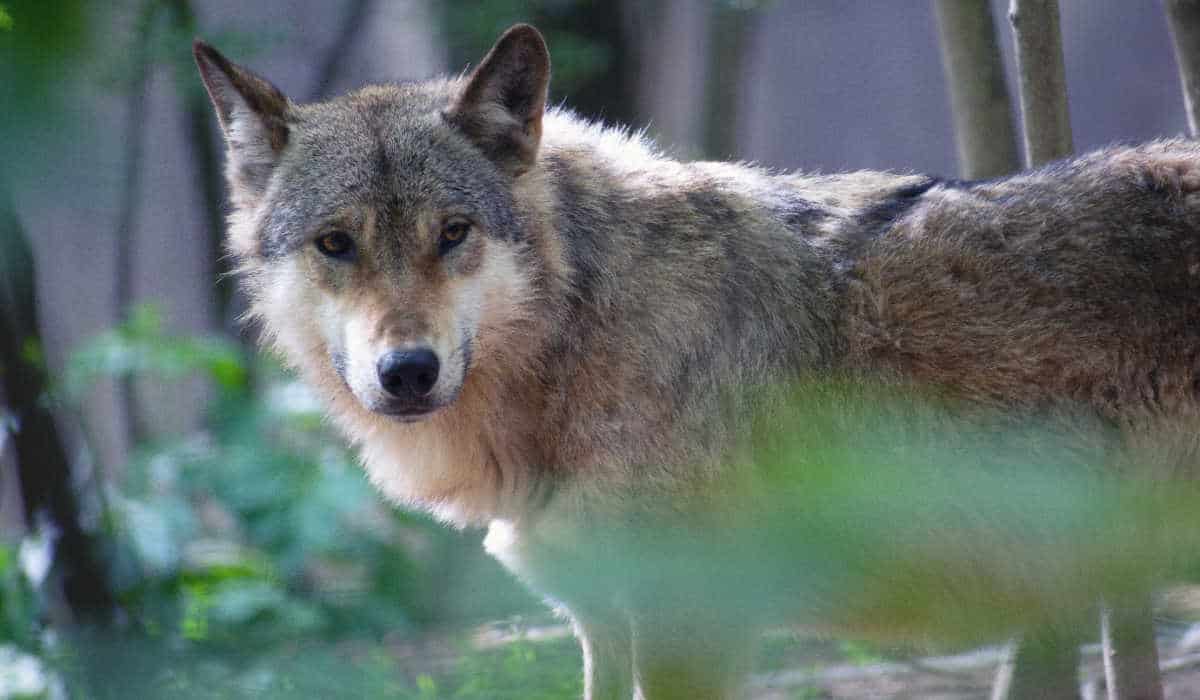Wolves have long been a subject of fascination and curiosity, with their presence often sparking debate and intrigue. In Missouri, the question of whether or not wolves can be found roaming within state borders continues to garner interest among residents and wildlife enthusiasts alike.
Gray wolves, also known as timber wolves, were once extirpated from Missouri. However, recent reports suggest there are approximately 50 wolves currently residing in the state.
Although there are other states in the area that are working to increase and wolf population in the region (North Carolina, for example, is known for being a recovery area for the red wolf) Missouri is playing a more significant role in the preservation of the gray wolf population.
Missouri is also home to the Endangered Wolf Center, which is dedicated to preserving and reintroducing endangered wolf species, such as the American red wolf, back into the wild. Although gray wolves are a federally endangered species, sightings in Missouri have gained attention and continue to contribute to the ongoing conservation efforts for these remarkable animals.
Presence of Wolves in Missouri
Wolves in Missouri have been rare in the past due to human activities, such as commercial wolf hunting, trapping, and wildlife encroachment. These actions endangered the wolf species in the state as far back as the early 1900s (and drove them totally extinct in Arkansas). However, individual wolves do occasionally wander into Missouri from neighboring areas.
It has been documented that wolves in Missouri appear to be young animals seeking new territories, away from areas populated by other wolves. One notable instance occurred in 2001, when a wolf appeared in Missouri sporting a radio collar and an ear tag linking it to Michigan’s Upper Peninsula, which is more than 600 miles away.
Missouri does not have a permanent wolf population at present. Nevertheless, various efforts are in place to conserve and protect the species. The Endangered Wolf Center in Eureka, Missouri, for example, is working on bringing red wolves back from the brink of extinction. Fewer than 20 American red wolves live in the wild in the United States.
In addition to conservation programs, Missouri State Statute ensures that no person can own lions, leopards, tigers, jaguars, margays, or any other dangerous wild animals, including wolves. This measure is in place to restrict and control the risks involved with owning and sustaining wild animals, further protecting their populations.
Wolf Species of Missouri
Grey Wolves
Grey wolves, also known as Canis lupus, were once native to Missouri and the surrounding region. However, they are now considered rare and extirpated from Missouri due to excessive wolf hunting, trapping, and human encroachment on wildlife habitats. Grey wolves are large canids, with adults typically weighing between 50 and 100 pounds. Despite their endangered status, there have been occasional reports of grey wolf sightings in Missouri, but these instances are infrequent and are likely the result of lone wolves traveling from neighboring states with larger wolf populations, such as Michigan, Minnesota, or Wisconsin.
Red Wolves
The red wolf (Canis rufus) is another species that once inhabited southern and eastern Missouri. Sadly, the red wolf is one of the world’s most endangered canids, and they have been entirely eliminated from the state of Missouri. These medium-sized predators mostly prey on smaller mammals such as rabbits and rodents and are slightly smaller than grey wolves. They can be distinguished by their reddish-tawny coats and slimmer builds. There are currently no known red wolf populations in Missouri.
Timber Wolves
The term “timber wolf” is actually another name for the grey wolf (Canis lupus), and it is primarily used to describe the subspecies found in forested habitats. As such, the information on grey wolves in Missouri also applies to timber wolves.
In summary, Missouri was home to both the grey (timber) wolf and red wolf species in the past, but today, their numbers have declined severely due to human activities, and they are considered extirpated from the region. While wolf sightings in Missouri are rare, the possibility of a stray grey (timber) wolf wandering from a neighboring state exists, but the red wolves are no longer found in the state.
Historical Extinction and Current Endeavors
In the past, Missouri was home to gray wolves, primarily in the northern region of the state. However, due to commercial hunting, habitat destruction, and other human activities, gray wolves became extinct in Missouri by the late 1800s.
Occasionally, individual wolves may wander into Missouri from neighboring states like Minnesota, Wisconsin, and Michigan. While these wolves are no longer considered a threat to humans, they represent an interesting and valuable component of the ecosystem.
The red wolf, another canid species, experienced a similar fate, being declared extinct in the wild in 1980. However, a captive breeding program has resulted in the red wolf being successfully reintroduced into a small area in northeastern North Carolina.
The efforts to preserve and protect endangered wolf species are ongoing. One such initiative is the Endangered Wolf Center in Eureka, Missouri. This non-profit wildlife facility, founded in 1971 by renowned naturalist Marlin Perkins, is dedicated to preserving and reintroducing critically endangered wolf species to the wild. The center is certified by the Association of Zoos and Aquariums (AZA), and interested visitors can tour the facility by making a reservation.
In November 2020, the U.S. Fish & Wildlife Service finalized a rule stripping the gray wolf of federal Endangered Species Act (ESA) protections, citing its “successful recovery.” This decision has sparked controversy and highlights the ongoing challenges faced by various efforts to ensure the continued survival and well-being of wolf populations not only in Missouri but across the United States.
Role in the Ecosystem
Predation Pattern
Wolves, as apex predators, play a significant role in maintaining the health and balance of ecosystems. Their predation patterns often focus on the vulnerable and weaker individuals in a population, such as sick or older animals. This selective predation helps regulate the population sizes of various species, such as deer, rabbits, and rodents, keeping their numbers in check.
In Missouri, gray wolves are larger and more robust than the more commonly seen coyotes. Wolves are opportunistic predators and adapt to a variety of prey, from large ungulates like deer, elk, and moose to smaller animals like beaver, rodents, and even fish. Their impact on the ecosystem extends beyond just prey population control, as their hunting habits also encourage healthier, more resilient populations of both prey and fellow predators like foxes and raccoons.
Impact on Other Animals
Wolves have an indirect effect on other animal populations in their ecosystems through the complex relationships propagated within their prey populations. By controlling the numbers of herbivores like deer and elk, wolves help prevent overgrazing, preserving the structure of plant communities. This preservation of habitat allows other small mammals and birds, such as squirrels, mice, and songbirds, to thrive.
In addition, when wolves influence the behavior of their prey, they cause a change in the foraging patterns and movements of these animals. This shift, in turn, can benefit other species, such as birds of prey or smaller carnivores like foxes, raccoons, and skunks, by altering how they access food and resources.
By maintaining equilibrium in the ecosystem, wolves play a crucial role in supporting biodiversity and overall ecosystem health. This is essential for the well-being of both wildlife and human communities sharing the same environment.
Threats and Challenges To Wolves In Missouri
Habitat Loss
The primary challenge faced by wolves in Missouri is habitat loss. As humans have encroached upon wilderness areas, the wolves’ natural habitat has been fragmented and destroyed. Additionally, Missouri’s increasing urbanization has impacted the wolves’ survival by limiting available space and resources.
Hunting and Trapping
A significant factor contributing to wolves’ declining population in Missouri has been hunting and trapping. Intensive and unregulated hunting during the early 1900s nearly drove these majestic animals to extinction in this region. Though the gray wolf is currently listed as endangered by the U.S. Fish and Wildlife Service in 47 states, hunting and trapping continue to pose a threat to their population.
Furthermore, there has been an increase in mountain lion sightings in Missouri, which creates added competition for resources and habitat with the already struggling wolf population. Similarly, other predators like bobcats can also create conflicts over territory and food sources.
Livestock depredation is another challenge faced by wolves in Missouri. As wolves search for food, they might come into contact with livestock, leading to conflict with farmers and increased hunting of the predators. Protecting farmlands and livestock is essential, but it often comes at the expense of the wolves’ survival in this region.
Overall, habitat loss, hunting and trapping, competition with other predators, and human-wildlife conflict present significant challenges to wolf conservation in Missouri.
Missouri’s Other Endangered Species
Missouri is home to several endangered or threatened species, including mammals such as bears, elk, mountain lions, bobcats, and various bat species, some of which face similar challenges to the gray wolf.
The black bear population has made a comeback in recent years, with an increasing number being sighted in southern Missouri. Similar to the gray wolf, black bears were once driven close to extirpation in the state due to habitat loss and overhunting. Conservation efforts have allowed their numbers to increase, though they still face threats from human-wildlife conflicts and habitat fragmentation.
Elk, once extirpated from Missouri, have been successfully reintroduced through a restoration program. Conservation initiatives have worked to establish and maintain the elk population, with the first elk hunting season held in 2020. The success of reintroducing elk into Missouri showcases the potential benefits of well-orchestrated conservation and reintroduction efforts for other endangered species, such as the gray wolf.
Mountain lions, also known as cougars, are another example of an endangered species in Missouri. Sightings of these elusive mammals are extremely rare and believed to be wanderers from other states with more established populations. The mountain lion’s ability to move across large distances and adapt to various habitats has sparked interest in the potential for their populations to rebound, much like the gray wolf’s sporadic appearances in the state.
Bobcats, though not as threatened as other mammal species mentioned, still face challenges due to habitat loss and human-wildlife interactions. They share similarities with gray wolves in their need for large, well-connected habitats to maintain healthy populations.
Various bat species in Missouri, including the Seminole bat, big free-tailed bat, and Brazilian free-tailed bat, also face endangerment due to habitat loss and disease, showcasing the precarious nature of many smaller mammal populations. While their situations differ from those of larger mammals like wolves and bears, they serve as additional examples of the challenges faced by endangered species.
In conclusion, Missouri’s endangered species, including gray wolves, face similar challenges resulting from human activities, habitat loss, and fragmentation. Successful conservation and reintroduction efforts for species such as elk have shown that with appropriate measures, these vulnerable populations can recover and contribute to the state’s diverse ecosystem.
Missouri Department of Conservation and Other Organizations
The Missouri Department of Conservation (MDC) plays a crucial role in managing and conserving the state’s wildlife resources, including providing information on various species such as the gray wolf. Historically, gray wolves inhabited northern Missouri, but due to factors such as commercial hunting and habitat encroachment, the population went extinct in the late 1800s.
Occasionally, individual gray wolves wander into Missouri from neighboring states like Minnesota, Wisconsin, or Michigan. MDC, along with biologists and other experts, monitors the presence of these animals and provides vital information on their habits and conservation status.
MDC is also responsible for tracking sightings of other large carnivores in Missouri, like mountain lions. As an organization, they work on offering guidance and advice on how to deal with these animals safely, ensuring the welfare of both people and wildlife.
Captive breeding programs play a crucial role in the conservation and recovery of endangered species. One such example is the Endangered Wolf Center in Eureka, Missouri, which works to protect and repopulate red wolves, an endangered species in North America. This center cooperates with other conservation organizations, including the Fish and Wildlife Service, to establish and implement recovery programs for endangered wolves.
Several groups and organizations share the goal of conserving and protecting Missouri’s wildlife. By working together, these entities foster enhanced ecosystem conservation, implement targeted protection plans for endangered species, and monitor wildlife population trends, thus ensuring the long-term sustainability of Missouri’s natural habitats and the species that call them home.
Comparison with Other Geographic Locations
Wolves in Missouri have become quite rare since their population was eliminated by the early 1900s. However, looking at other geographic locations in North America, wolf populations present a varied picture.
In contrast to Missouri, the Great Lakes states of Minnesota, Wisconsin, and Michigan have seen significant growth in their wolf populations, primarily attributed to sustainable conservation efforts. The presence of gray wolves is more abundant in these areas, providing better ecosystem balance.
The Northern Rocky Mountains, which includes states like Idaho, Montana, and Wyoming, also harbor a decent population of gray wolves. Specifically, Yellowstone National Park is home to a notable number of wolves that are protected and managed in the park, promoting the natural regeneration of the species.
Meanwhile, the northeastern region of North America, including Canada and Alaska, boasts a healthy population of arctic wolves. These remote locations provide a suitable habitat and a lower level of human interference, allowing arctic wolf populations to thrive.
In the Southern regions, such as North Carolina and Ozarks, the presence of wolves is quite limited. The red wolf, specifically found in northeastern North Carolina, faces challenges with habitat loss and interbreeding with coyotes.
Overall, it’s essential to consider the factors that affect wolf populations in different regions across the U.S. and North America. The neighboring states and territories indicate a varying degree of success in sustaining wolf populations, with conservation efforts playing a significant role in their continued survival.
Human Interaction
Wolves are rare in Missouri and are considered extirpated due to various human activities. For example, excessive wolf hunting, trapping, and wildlife encroachment have led to their scarcity. Though not prevalent, individual wolves sometimes stray into Missouri from other states, particularly from Michigan, Minnesota, and Wisconsin.
The Missouri Department of Conservation plays a vital role in monitoring and managing wildlife in the state, including wolf populations. They provide valuable information on species such as the gray wolf, which has a similar appearance to the coyote but is larger and more robust. Gray wolves can occasionally be found in Missouri, although they are extremely uncommon.
When it comes to human interaction with these individual wolves, there can be some concerns regarding possible conflicts or issues that could arise. One main concern is related to livestock safety. As natural predators, wolves may pose a threat to farm animals, which can be especially concerning for local farmers. However, with the low presence of wolves in the state, such conflicts are quite uncommon.
In conclusion, while wolves are not frequently found in Missouri, it’s essential for local inhabitants and various organizations like the Missouri Department of Conservation to be knowledgeable about and prepared for any potential interactions with these rare creatures.
Missouri’s Wolf Status – Conclusion
The gray wolf, also known as the timber wolf, was once present in Missouri. However, due to human activities such as commercial hunting, trapping, and wildlife encroachment, the wolf population began to decline as early as the early 1900s. Currently, gray wolves are considered extirpated from Missouri, meaning they no longer have a confirmed resident population in the state.
Although wolves are rarely seen in Missouri, there have been occasional sightings and reports of their presence in the area. These instances are mostly regarded as rare events. When it comes to determining a specific location for spotting wolves in Missouri, it is quite challenging, as there is no confirmed wolf population in the state to base these sightings on.
Missouri’s documented large carnivore encounters mainly consist of confirmed mountain lion sightings, which have been verified by the Missouri Department of Conservation in various counties. It is essential to note that these sightings pertain to mountain lions, not gray wolves.
In conclusion, it is unlikely to encounter a gray wolf in Missouri due to the extirpated status of the species in the state. While occasional sightings cannot be entirely ruled out, they remain rare occurrences, and the state currently has no confirmed resident wolf population.







